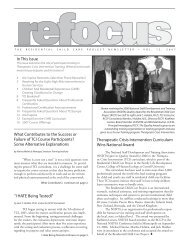The Therapeutic Crisis Intervention System - Residential Child Care ...
The Therapeutic Crisis Intervention System - Residential Child Care ...
The Therapeutic Crisis Intervention System - Residential Child Care ...
You also want an ePaper? Increase the reach of your titles
YUMPU automatically turns print PDFs into web optimized ePapers that Google loves.
Learning From Tragedy: <strong>The</strong> Results<br />
Of a National Study af Fatalities in<br />
Out-of-Home <strong>Care</strong><br />
Introduction<br />
Recent newspaper stories in the United States have<br />
drawn attention to fatalities that have occurred over<br />
the past decade where physical and mechanical<br />
restraints, psychotropic medication, isolation, and<br />
seclusion appeared to play a major role in the deaths<br />
of both adults and children. <strong>The</strong> 1998 series in the<br />
newspaper, <strong>The</strong> Hartford Courrant documented,<br />
over a 10-year period, 142 fatalities of individuals<br />
whose ages range from 6 years to 78 years where a<br />
combination of physical and mechanical restraints,<br />
psychotropic medication, isolation, and/or seclusion<br />
contributed to death. As a result of this series,<br />
as well as other media attention on subsequent<br />
deaths, federal and state legislation and regulations<br />
have been proposed which would limit the use of<br />
physical and mechanical interventions with children,<br />
and well as banning outright certain techniques.<br />
Professional organizations and accreditation<br />
organizations have followed suit and have outlined<br />
restrictions on the use of physical and mechanical<br />
interventions and techniques. Often these legislative<br />
and regulatory shifts have taken place with little but<br />
newspaper accounts of the fatalities to inform these<br />
modifications.<br />
Survey Methodology<br />
In 1998 Cornell University’s Family Life<br />
Development Center surveyed how children die in<br />
foster care, kinship care, group homes, residential<br />
care, and juvenile correction facilities. <strong>The</strong> survey<br />
had two distinct strategies: a mailed survey approach<br />
and an internet newspaper search. A 43-question<br />
survey was mailed to each of the 50 states, as well<br />
as the District of Columbia, the Commonwealth of<br />
Puerto Rico, and the Virgin Islands. <strong>The</strong> survey asked<br />
child welfare, youth correction, mental health, and<br />
developmental disability officials for child (age 18 or<br />
under) fatality information for the years 1996, 1997,<br />
and 1998 from their sponsored or licensed facilities.<br />
Research Foundations of TCI<br />
<strong>The</strong> survey resulted in a return of 71 surveys from 42<br />
states and the District of Columbia. This represents<br />
a 39% return rate. This mail survey was augmented<br />
by a second strategy: an internet search for fatalities<br />
to children in out-of-home care due to restraint and<br />
isolation.<br />
Survey Findings<br />
Our mailed survey indicates that the vast majority<br />
of children who died in residential care died from a<br />
chronic disease or condition. Other circumstances<br />
(in much smaller numbers) included fatalities due<br />
to homicide, suicide, accidents, and isolation and<br />
restraint. <strong>The</strong> remainder of this review will only<br />
address those deaths that had physical or mechanical<br />
restraints as causative or contributing factors.<br />
Our internet search uncovered 18 such fatalities,<br />
while our traditional survey documented only 8<br />
of these 18 fatalities. <strong>The</strong> 17 of the 18 fatalities<br />
uncovered by the internet search were reported in<br />
the 1998 Hartford Courrant report.<br />
• Age and gender. <strong>The</strong> overwhelming majority of<br />
the fatalities were males (n=14). Both males and<br />
females ranged from 6 to 17 years in age with a<br />
mean of 14 years.<br />
• Immediate cause of death. Positional asphyxia was<br />
listed as the leading cause of death (n=8). Cardiac<br />
arrhythmia or cardiac arrest occurred in four<br />
cases, while the remaining causes were listed as<br />
strangulation (n=1), aspiration (n=1), unspecified<br />
or unknown (n=4). While psychotropic<br />
medication appeared to play a part in two fatalities,<br />
the psychotropic medication history was unknown<br />
in the vast majority of cases.<br />
• Circumstances surrounding the fatalities. Four<br />
fatalities occurred in some form of mechanical<br />
restraint, while 14 fatalities were a result of physical<br />
intervention. In 7 of the 14 cases of physical<br />
restraint, there was only 1 staff worker involved.<br />
In three of the physical intervention fatalities,two<br />
staff workers were involved, and in the remaining<br />
four physical intervention fatalities, the number<br />
of staff workers involved was unknown. In two<br />
THERAPEUTIC CRISIS INTERVENTION SYSTEM: <strong>Residential</strong> <strong>Child</strong> <strong>Care</strong> Project, Cornell University 13



